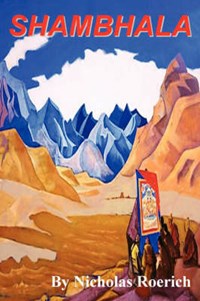Shambhala
Roerich Nicholas

|

Asia
Sikkim
Tibet
|
|
Pagine - Pages
|
326
|
|
Titolo originale
|
Shambhala, the Resplendent
|
|
Lingua - language - langue
|
eng
|
|
Ristampa - Réédition - Reprint |
2003 Kessinger - 2003 Vedams
|
|
|
|
|
|
|
|
|
|
|
|
|
|
|
|
 Shambhala
Shambhala

"For some, Shambhala is the truth; for others Shambhala is an Utopia. For some, the Lord of Shambhala is a Sage; for others the Lord of Shambhala is the manifestation of abundance. For some, the Lord of Shambhala is an adorned idol; for others the Lord of Shambhala is the guide of all planetary spirits. But we shall say – the Lord of Shambhala is a Fiery Mover of Life and of the Fire of the Mother of the World. His breath glows with flame and his heart burns with the fire of the Silvery Lotus. The Lord of Shambhala lives and breathes in the heart of the Sun!
"All peoples know that the site of the holy men is on the mountains, upon the peaks. From the peaks comes revelation. In caves and upon the summits lived the Rishis. There where the rivers find their sources, where the eternal ice has preserved the purity of whirlwinds, where the dust of meteorites carries a purifying armour from the distant worlds, - there is the rising glow. Thither is directed the striving of the human spirit. In their very difficulty the mountain paths attract one. There the unexpected occurs. There the people’s thought moves towards the ultimate. There each pass promises an unprecedented novelty, gives promise of the hewing of new facets of tremendous outline.
"Over the snowy peaks of the Himalayas burns a bright glow, brighter than stars and the fantastic flashes of lightning. Who has kindled those pillars of light, which march across the heavens? The polar and mid-night regions are not near. The northern lights cannot glimmer in the Himalayas. Not from the Northern scintillations are these pillars of light. They come from Shambhala; from the Tower of the Great Coming One."
Note.
1. Shambhala, The Resplendent (Talai-Pho-Brang, 1928).
2. Treasure of the snows (Talai-Pho-Brang, 1928).
3. Buddhism in Tibet (Kampa Dzong, 1928).
4. Tibetan art (Shekar Dzong, 1928).
5. The Veils of death (Nagchu, 1927).
6. Obsession (Ulan Bator Khoto, 1927).
7. Chingiz-Khan (A Song).
8. Lakshmi, the Victorious.
9. The boundaries of the kingdom.
10. Hidden treasures.
11. Jalnik, the site of compassion.
12. Gayatri.
13. Dreams.
14. The desert cities.
15. Lyut, the giant.
16. Star of the mother of the world (Talai-Pho-Brang, 1924).
17. Praise to the enemies (Kashmir, 1925).
18. A letter (Ulan Bator Khoto, January, 1927).
19. Urusvati (Naggar, 1929).
20. Son of the King (Altai, 1926).
21. Subterranean dwellers (Tangoo, 1928).
22. Light in the desert (Gantok, 1928).
23. Gods of Kuluta (Naggar, 1929).
24. King Solomon (Talai-Pho-Brang, 1928).
25. The great mother (Talai-Pho-Brang, 1928).
26. Joy of creation (New York, 1929).
27. Guru—the teacher.
|
|
Consulta anche:
Acquista di Shambhala (ed. Amrita) in lingua italiana
|
|
|
|
Recensione in lingua italiana |
|
“Lama, parlami di Shambhala!”
“Ma voi Occidentali non sapete nulla di Shambhala, e non desiderate conoscere nulla sull’argomento. Le vostre domande altro non sono, probabilmente, che curiosità; e pronunciate questo nome sacro senza alcun rispetto...”
Così inizia, con grande reticenza, il lungo dialogo fra Roerich e un lama tibetano che chiederà di restare anonimo, ma che ben presto, scoprendo il profondo rispetto del suo interlocutore, dirà su Shambhala più di quanto sia mai stato detto.
Roerich è poco conosciuto in Italia. mi sono imbattuto in lui leggendo un articolo di Vincent Bellezza che negli anni 90 ha cercato di ripercorrere alcuni tratti della spedizione di Roerich in Tibet (per inciso i dolmen da Roerich segnalati non esistevano più trasformati in chorten...).
Shambala è stato ripubblicato presso varie case editrici, ma questa è l'unica traduzione italiana.
Nel 1928, l’archeologo russo (ma anche pittore celeberrimo e letterato) si sposta ormai da anni con una spedizione nei paesi himalayani. Della spedizione fa parte anche il figlio George, che parla correntemente il tibetano.
Oltre a questo ormai famosissimo dialogo su Shambhala, e all’altrettanto famoso capitolo sui Popoli che vivono nell’interno della Terra, i due volumi contengono una singolare raccolta di leggende e tradizioni indo-tibetane, nonché una spietata descrizione del Tibet ormai giunto alla sua decadenza nei primi anni del secolo, ove tuttavia ancora sussiste, lontana dai palazzi del potere, la più pura spiritualità. |
|
|
Consulta anche:
Acquista di Shambhala (ed. Amrita) in lingua italiana
|
|